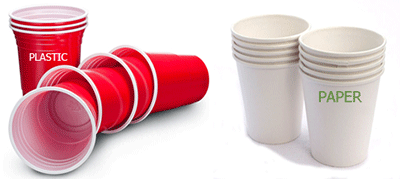Paper Cups Winning Market "War" with Plastic
![]() Print this Article | Send to Colleague
Print this Article | Send to Colleague

Ever since large mainstream companies like Starbucks began using paper cups to serve products, as they have been for several years now, the use of paper cups has become considerably more popular and important in the eyes of consumers. This is basically because of paper’s higher bio-degradability compared with its plastic counterparts.
The "paper over plastic" debate has now made its way from grocery bags to beverage cups. Five Guys Burgers and Fries (Five Guys Enterprises) even goes an extra step, choosing to serve fries and beverages in paper cups and only uses unbleached paper bags for holding the customer’s order.
When interviewed by the Wall Street Journal for a recent article debating paper vs. plastic cups, customer Stephanie Falk explained that she and her husband liked buying smoothies from the Jamba Juice Co. However, the San-Diego based couple chose to boycott the chain for several months last year over environmental concerns when they learned the potential long-term dangers of plastic-foam cups the company was using—plastic is not bio-degradable.
Consumers are now beginning to see with their own eyes what scientists have been warning about for some time. Plastic litter can last for generations, killing or injuring wildlife, and is currently known as one of the prime ingredients in the large "islands of trash" that are beginning to fill the Pacific Ocean. Paper, however, is biodegradable, and additionally, in landfills can serve as a type of filter, helping to filter out some toxins, metals, or other waste contaminates that could potentially pollute the water table below.
Now Jamba Co. serves products in paper cups. This type of change is being seen in many of the largest U.S. food chains where progressively more of their consumers are becoming environmentally conscious about how products are packaged and served. McDonald’s Corp. is replacing plastic-foam cups with McCafe paper cups at all 14,000 McCafes across the country. Dunkin’ Brands Group Inc. has said it is also testing new paper cups. The greatest challenge for the paper cup industry is to offer affordability that matches plastic’s competition. Currently, and partially due to lower demand and infrastructure, paper cups cost a few cents more to produce compared with their plastic alternative.
But McDonalds has learned how to use unique, structural properties of the paper cup to their advantage, making the transition worth it by ensuring any extra costs go towards ensuring their customers have properly insulated products. McDonald's has been using double-walled paper cups that have a small pocket of air between them to increase insulation at about 2,000 restaurants along the West Coast since 2012. Now it is expanding into the Midwest and parts of the East Coast, according to Ian Olson, McDonald’s director of sustainability.


